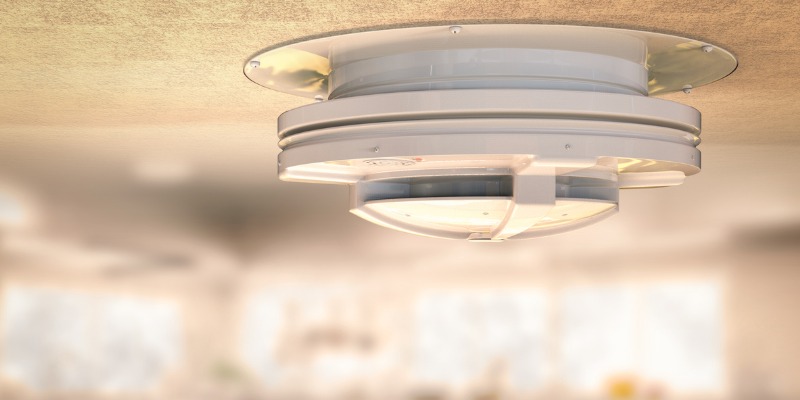Carbon monoxide (CO) is a colourless, odourless gas that can be deadly if inhaled. That’s why it’s important to have a carbon monoxide alarm in your home to detect this poisonous gas. In this article, we will answer some frequently asked questions about carbon monoxide alarms to help you keep your home and family safe.
How Do Carbon Monoxide Alarms Work?
Carbon monoxide alarms work by using a chemical sensor to detect the presence of carbon monoxide in the air. When the alarm detects a certain level of carbon monoxide, it will sound an alarm to alert you to the potential danger.
How Do I Know If My Carbon Monoxide Alarm Is Working?
Most carbon monoxide alarms have a test button that you can press to ensure that the alarm is functioning properly. It’s important to test your carbon monoxide alarm regularly to make sure it’s working.
If you need to reset a carbon monoxide alarm, simply press the reset button on the alarm. If the alarm won’t reset, it may be a sign that the battery needs to be replaced or there is a problem with the alarm itself.
Where Should I Install A Carbon Monoxide Alarm?
It’s recommended to install a carbon monoxide sensor on every level of your home and in close proximity to any appliances that may produce carbon monoxide, such as a furnace or water heater.
What Do You Do If A Carbon Monoxide Alarm Goes Off?
If a carbon monoxide alarm goes off, you should immediately evacuate your home and call 911. Do not try to locate the source of the carbon monoxide leak or turn off any appliances yourself.
Once you are safely outside, wait for emergency services to arrive and follow their instructions. If anyone in your household is experiencing symptoms of carbon monoxide poisoning, such as headache, dizziness, or nausea, they should seek medical attention as soon as possible.
What Appliances Can Cause A Carbon Monoxide Alarm To Go Off?
Appliances that use natural gas, propane, or oil can produce carbon monoxide as a byproduct of their operation. This includes furnaces, water heaters, stoves, fireplaces and anything else that uses combustible fuels.
Are Smoke Alarms Carbon Monoxide Detectors?
No, smoke alarms and carbon monoxide alarms are two separate types of devices. Smoke alarms are designed to detect particles of smoke, while carbon monoxide alarms are designed to detect the presence of carbon monoxide gas. It’s important to have both types of alarms in your home for maximum safety.
How Often Should I Test My Carbon Monoxide Alarm?
It is recommended to test your CO detector at least once a month to ensure it’s working properly. While not necessary for most plug-in carbon monoxide detectors, it’s also a good idea to replace the battery in your portable carbon monoxide alarm every year.
How Can I Prevent A Carbon Monoxide Leak?
There are several steps you can take to prevent a carbon monoxide leak in your home, such as:
- Have your heating system, water heater, and any other gas-powered appliances inspected and serviced annually
- Make sure appliances are properly installed and vented according to the manufacturer’s instructions
- Never use gas appliances such as stoves, ovens, or grills to heat your home
- Do not leave vehicles running in your garage
- Do not block air intakes or exhaust vents on appliances
- Install carbon monoxide alarms on every level of your home, especially near bedrooms
By following these precautions, you can help protect your family from the dangers of carbon monoxide leaks.
Do Carbon Monoxide Alarms Expire, And If So, How Often Do They Need To Be Replaced?
Carbon monoxide alarms do expire, typically after about 7-10 years. It is important to check the expiration date of your carbon monoxide alarms and replace them when needed. It is also a good idea to have a few extra carbon monoxide alarms on hand in case one of your alarms reaches its expiration date and needs to be replaced.
How Can I Improve Overall Indoor Air Quality?
Beyond preventing carbon monoxide exposure, there are several ways to improve the overall indoor air quality in your home:
- Keep your home clean and dust-free by regularly cleaning surfaces and using a high-efficiency air filter in your heating and cooling system.
- Use an air quality monitoring device.
- Use natural or low-VOC cleaning products to reduce the amount of harmful chemicals in the air.
- Properly ventilate your home by opening windows and using exhaust fans when cooking, cleaning, or bathing.
- Do not allow smoking within the home.
- Consider investing in an air purifier to remove additional contaminants from the air.
- Have your heating and cooling system professionally serviced regularly to ensure it’s operating safely and efficiently.
Connect With The Experts At Air Treatment ClimateCare
Keep your home and family safe from carbon monoxide by installing and maintaining functioning CO detectors. By following our guidelines in this article, you can ensure your alarms are protecting you from this invisible and deadly gas.
For additional peace of mind, consider working with the professionals at Air Treatment ClimateCare for CO alarm installation and servicing. Our team will also be happy to help you improve your home’s overall indoor air quality with top-of-the-line ventilation appliances. Contact us today to learn more!








